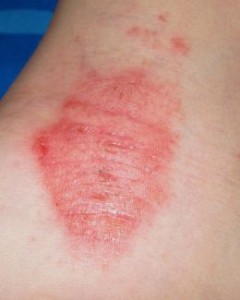 The skin serves as a barrier protecting the body from the hundreds of allergens, irritants, pollutants and microbes’ people come in contact with every day. Eczema, or atopic dermatitis is considered the most common inflammatory human skin disease. In eczema patients the skin barrier becomes open, allowing intruders – pollen, mold, pet dander, dust mites and others – to be absorbed by the skin and in turn create chaos on the immune system.
The skin serves as a barrier protecting the body from the hundreds of allergens, irritants, pollutants and microbes’ people come in contact with every day. Eczema, or atopic dermatitis is considered the most common inflammatory human skin disease. In eczema patients the skin barrier becomes open, allowing intruders – pollen, mold, pet dander, dust mites and others – to be absorbed by the skin and in turn create chaos on the immune system.
The upper-most layer of the skin known as the stratum corneum, has been determined to be the culprit in previous research, a new study published in the Journal of Allergy and Clinical Immunology found that a second skin barrier structure, consisting of cell-to-cell connections known as tight junctions, is also responsible for eczema and plays a big role in the development of the eczema on the skin. Tightening both porous areas may be an effective treatment strategy for eczema patients, who often have limited options to treat the disease.
“Over the past five years, disruption of the skin barrier has become a central hypothesis to explain the development of eczema,” said Lisa Beck, M.D., lead study author and associate professor in the Department of Dermatology at the University of Rochester Medical Center. “Study findings challenge the belief that the top layer of the skin or stratum corneum is the sole barrier structure: It suggests that both the stratum corneum and tight junctions need to be defective to jumpstart the disease.”
Eczema affects up to 17 percent of children and about six percent of adults in the United States – close to 15 million Americans. There are no treatments that target skin barrier dysfunction in eczema. To treat eczema, which causes dry, red, itchy skin, physicians typically prescribe anti-inflammatory drugs, like prednisone, and a variety of topical anti-inflammatory creams and ointments. But, modest benefit, negative side effects and cost concerns associated with these therapies leave patients and doctors eagerly awaiting new alternatives.
“The Study wanted to figure out what current eczema therapies do to both barrier structures and start thinking about new treatments to close the breaks that let irritants in and water out and subsequently drive the inflammation and dryness that is characteristic of the disease,” noted Beck, who treats eczema patients in addition to conducting research on the condition.
Beck and her team studied skin samples from eczema patients and healthy individuals to understand the role of tight junctions in eczema. Using resistance and permeability tests, they discovered that tight junctions that control the passage of water and particles were strong and tight in healthy skin samples, yet porous in the skin of eczema patients.
They also found that a particular tight junction protein, claudin-1, determines the strength and permeability of tight junctions in skin. They discovered that this protein was significantly reduced in the skin of eczema patients, but not in healthy individuals or individuals with psoriasis, another common chronic skin disease.
“Since claudin-1 was only reduced in eczema patients, and not the other controls, it may prove to be a new susceptibility gene in this disease,” said Anna De Benedetto, M.D., postdoctoral-fellow at the Medical Center and first author of the new study. “The hypothesis is that reduced claudin-1 may enhance the reactivity to environmental antigens and lead to greater allergen sensitization and susceptibility in people with eczema.”
If the team’s hypothesis stands up in future research, increasing claudin-1 to combat eczema could be a new treatment approach worth exploring.
Several studies published in reputable medical journals show that maintaining a healthy immune system is quite beneficial for optimal skin health and can aid in helping eczema patients.

